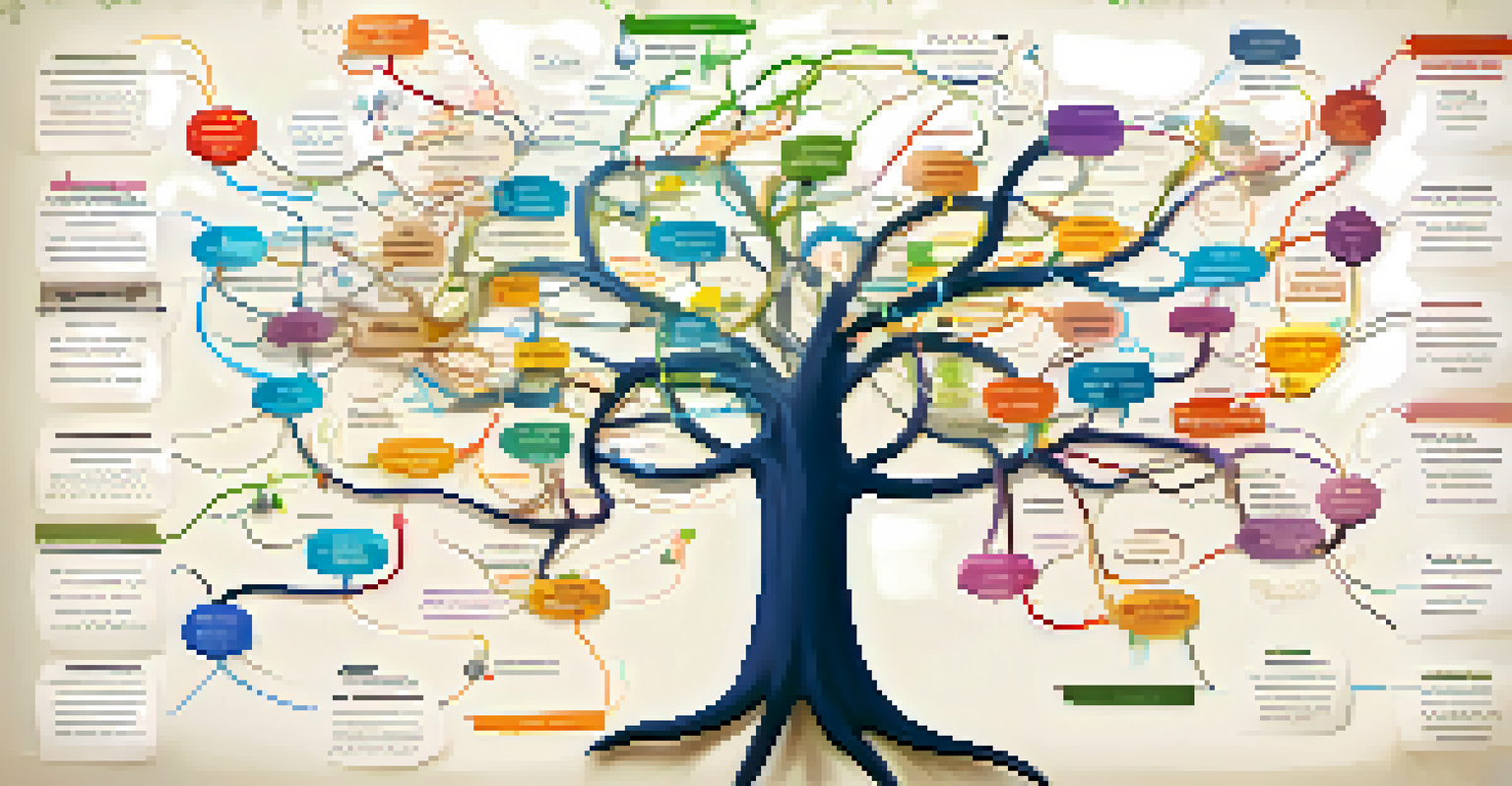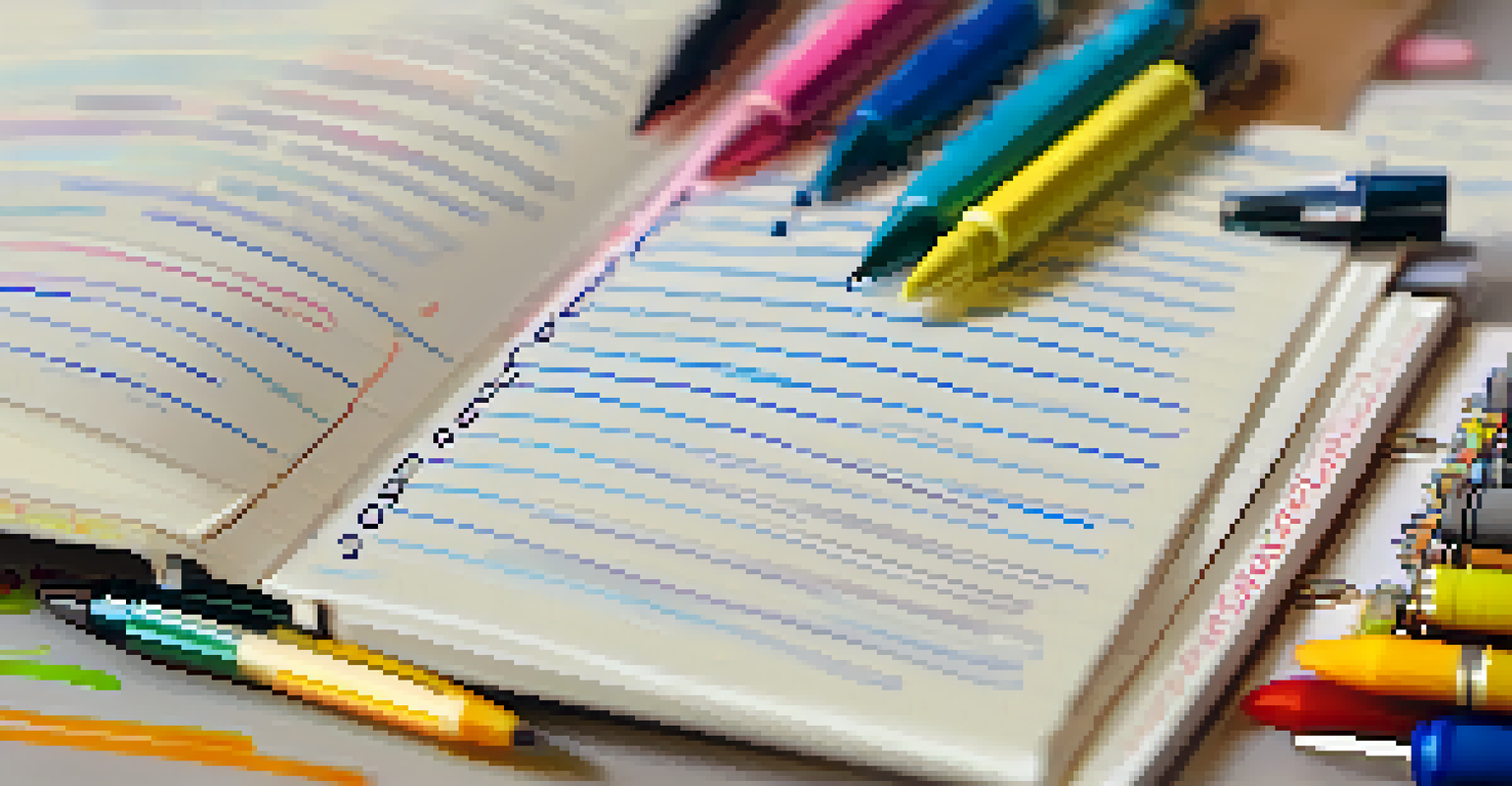Mind Mapping vs. Traditional Note-Taking: A Comparative Study

Understanding Mind Mapping and Its Benefits
Mind mapping is a visual technique that helps organize information by creating a diagram that connects ideas. This method allows you to see the big picture and make connections between concepts more clearly. It's particularly useful for brainstorming sessions and project planning, as it encourages creativity and flexibility. By using colors, images, and branches, you engage different parts of your brain, making information more memorable.
The mind is not a vessel to be filled, but a fire to be kindled.
On the other hand, traditional note-taking typically involves linear notes, which can sometimes feel restrictive. While it is straightforward and familiar, it may not capture the relationships between ideas as effectively as mind mapping. Not to mention, it can lead to a more passive learning experience, where the focus is simply on writing down information without engaging with it. Thus, mind mapping can offer a more dynamic approach to learning and retention.
In essence, mind mapping transforms how we visualize information, making it an appealing alternative for those who thrive in a non-linear environment. It invites creativity, making learning feel less like a chore and more like an exploration. This can be particularly beneficial for visual learners who might struggle with traditional note formats.
The Basics of Traditional Note-Taking
Traditional note-taking is a well-established method that involves writing down information in a structured manner, often using bullet points or outlines. This approach is straightforward and can be easily organized, making it ideal for lectures and reading materials. Many people find comfort in this familiar format, as it allows for quick review and easy reference later on.

However, one downside is that traditional notes can become cluttered and overwhelming, especially if you try to capture everything verbatim. This can lead to important ideas getting lost in a sea of text. Additionally, it may not cater to different learning styles, particularly for those who benefit from visual representations of information.
Mind Mapping Enhances Creativity
This visual technique promotes creative thinking by allowing users to see connections and relationships between ideas.
Despite its limitations, traditional note-taking remains a popular method, particularly for those who prefer a more structured approach. It can be effective for organizing thoughts and ensuring that key points are captured. Understanding its strengths and weaknesses is vital in determining whether it suits your particular learning style.
Comparative Advantages of Mind Mapping
One of the main advantages of mind mapping is its ability to promote creative thinking. By laying out ideas visually, you can easily see connections and relationships that might not be apparent in traditional notes. This can lead to deeper understanding and more innovative solutions, making it a great tool for problem-solving.
You can’t use up creativity. The more you use, the more you have.
Mind maps also encourage active engagement, as you're not just passively recording information but actively organizing it. This can enhance retention and recall, allowing you to remember concepts more effectively. Moreover, the visual nature of mind maps makes them more appealing and easier to review later on.
Additionally, mind mapping can be highly adaptable. Whether you’re planning a project, preparing for an exam, or brainstorming ideas, this method can be tailored to fit your needs. The flexibility it offers makes it a versatile tool for various contexts, ensuring you have a system that works for you.
When to Use Traditional Note-Taking
While mind mapping has its benefits, there are moments when traditional note-taking may be the better option. For instance, in formal classroom settings or during lectures where a lot of information is presented, a structured approach can help you keep up with the content. Traditional notes allow you to categorize and prioritize information, which can be essential in understanding complex subjects.
Additionally, if you’re someone who processes information better through linear formats, traditional note-taking might be more effective for you. It allows for straightforward organization, enabling you to highlight key points and summarize information succinctly. This can be particularly helpful when reviewing material later, as you can easily locate specific details.
Traditional Notes Offer Structure
Structured note-taking is effective for capturing information in formal settings, making it easier to prioritize and review key points.
Furthermore, traditional notes can be beneficial in professional settings, such as meetings or conferences, where clarity and conciseness are key. In these scenarios, quickly jotting down important points can be more practical than creating a detailed mind map. Understanding when to switch between these methods can enhance your overall productivity.
Combining Mind Mapping and Traditional Note-Taking
Rather than choosing one method over the other, you might find that a combination of mind mapping and traditional note-taking works best for you. For example, you could use mind mapping for brainstorming sessions to generate ideas and then transfer the key points into traditional notes for more detailed study. This hybrid approach allows you to leverage the strengths of both methods.
Additionally, you can start with mind mapping to explore a topic broadly and then refine your understanding using traditional notes. This can create a more comprehensive learning experience where you not only capture details but also see how they fit into the bigger picture. It’s like having a roadmap while also having the directions.
Exploring both methods can empower you to adapt your approach based on the context and your personal preferences. Whether you lean more towards visual learning or structured notes, blending these techniques can enhance your overall effectiveness and retention.
Evaluating Your Learning Style
Understanding your learning style is crucial in determining whether mind mapping or traditional note-taking is a better fit for you. Visual learners, for instance, may thrive with mind mapping due to its graphical nature. In contrast, auditory learners might prefer traditional notes, as they can benefit from listening and writing simultaneously.
To evaluate your learning style, consider reflecting on past experiences. Ask yourself which methods helped you retain information best, or which formats felt more engaging. Sometimes, a simple trial and error approach can reveal insights about what works for you and what doesn’t.
Combine Methods for Best Results
Utilizing both mind mapping and traditional note-taking can create a more comprehensive learning experience tailored to individual preferences.
Once you recognize your learning preferences, you can tailor your note-taking strategies accordingly. This self-awareness will not only improve your study habits but also make learning feel more enjoyable and productive.
Final Thoughts: Choosing What's Right for You
In conclusion, both mind mapping and traditional note-taking have their own unique advantages and potential drawbacks. The key is to identify what resonates with you personally and aligns with your learning goals. If you find yourself overwhelmed by traditional notes, exploring mind mapping could open up new avenues of understanding.
Ultimately, the best choice may vary based on the context—some situations might call for the creativity of mind mapping, while others might benefit from the clarity of traditional notes. Give yourself permission to experiment and find the right balance that enhances your learning experience.

By being open to both methods, you can create a personalized approach that reflects your individual needs and preferences. Whether you’re brainstorming ideas or summarizing a lecture, the goal is to find a system that empowers you to learn effectively and enjoyably.